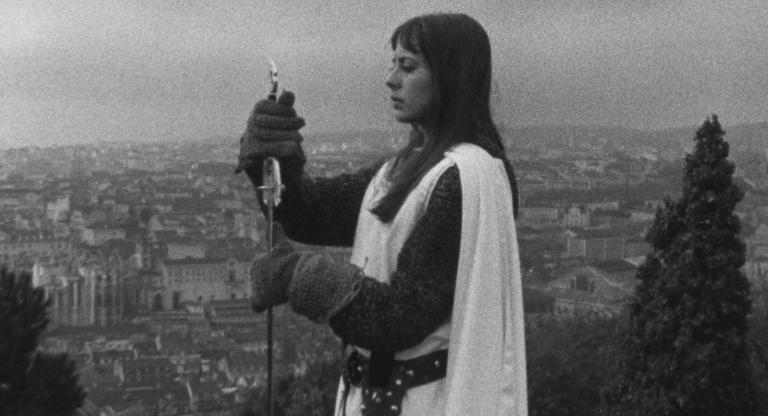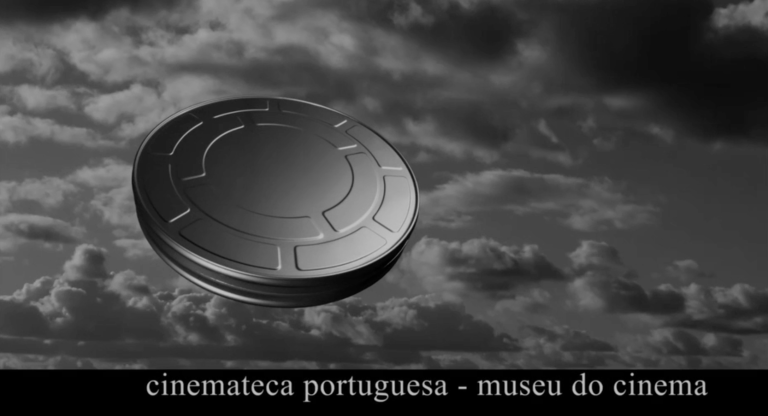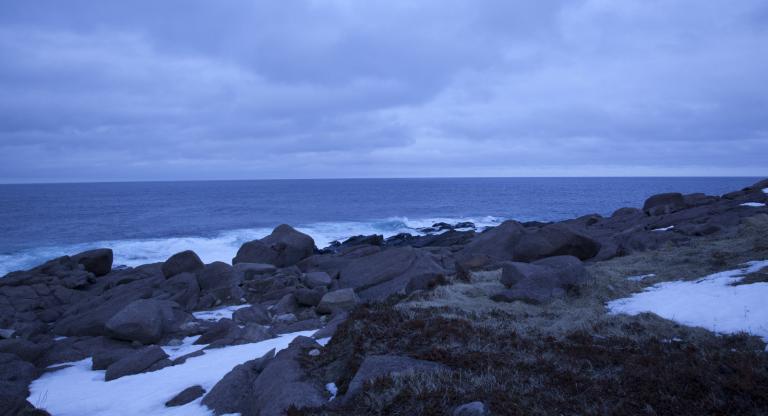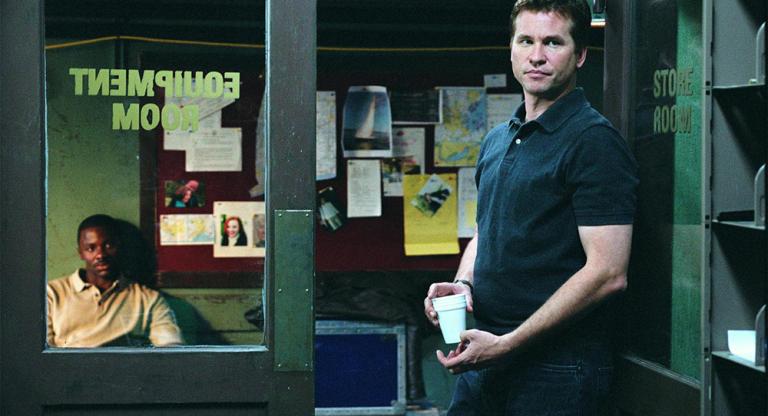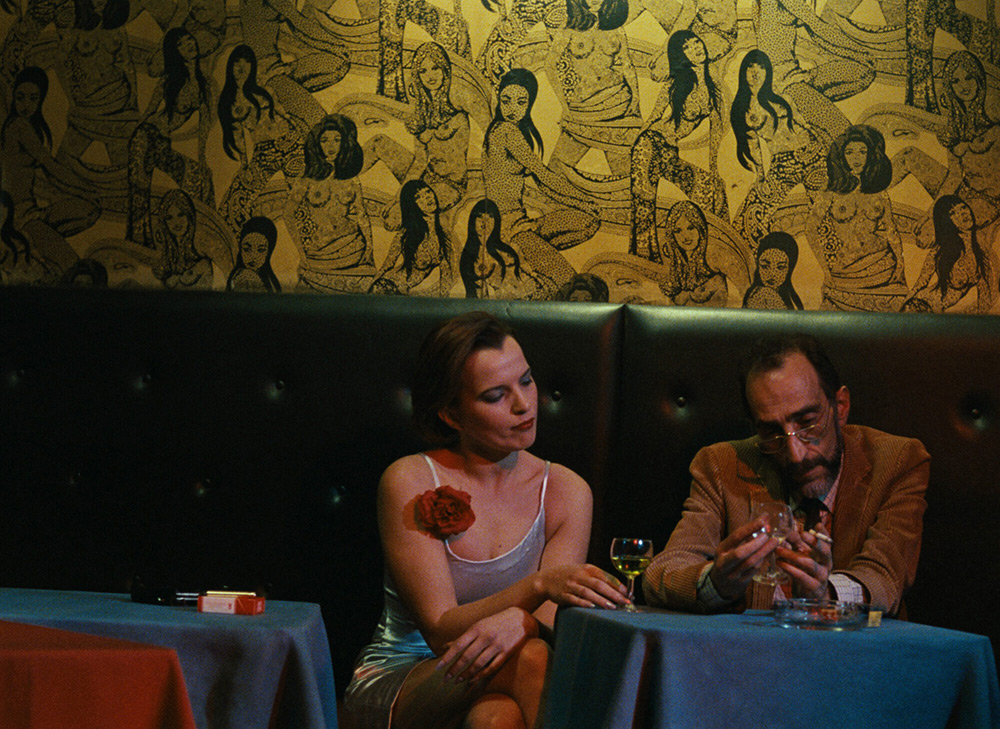
A brief account of a three-minute film: A spindly, well-dressed man strolls down a lamp-lit Lisbon street. As he reaches his apartment, the soundtrack of the most romantic scene from Nicholas Ray’s Johnny Guitar (1954) begins to play. The man indulges in a moment’s voyeurism—rebuffed when the woman in the neighboring apartment closes her window—then enters his home for a night spent alone. As the sounds of Sterling Hayden, Joan Crawford, and Victor Young continue to play on, he taps his fingers on his desk before going to the window for a smoke. The scene from Ray’s film nears its ecstatic climax and the camera moves toward the window and onto a view of the city. Crawford delivers her final line and now dawn is breaking over Lisbon. The sound of classic Hollywood gives way to that of everyday life as we hear the city begin its day; the cultivated loneliness of cinephilia returns us to the world anew.
The film is A Walk with Johnny Guitar (1996) and the man is its director, João César Monteiro, currently the subject of a comprehensive retrospective at the Museum of Modern Art that features, in addition to all of his films and never-before-seen screen tests, numerous other movies that form a constellation with Monteiro’s cinema (alas, not Ray’s film!). Much of what I find special about Monteiro’s cinema is condensed in those few minutes: the transposition of cinephilic fragments onto the lived geography of Portugal, the articulation of anti-sociality and popular life, a perverse eroticism and sublime use of natural light. A nearly unprecedented opportunity for those in New York to discover the Portuguese filmmaker’s work, “João César Monteiro: Symphonies of a Libertine” presents a sensuous, richly intertextual body of films that developed in singular opposition to fascism and bourgeois democracy alike. “Run from society like the devil from the cross,” Monteiro’s alter ego advises in his swan song Vai e Vem (2003), “The only society you should cultivate is your own . . . Against all fires, my fire.” Encountered today, when cinephilia is routinely confused with the mere chronic consumption of films, Monteiro’s work presents us with a vital example of cinema as a way of being in and against the world.
For Monteiro, that world was Portugal. Destined to come of age under the Estado Novo dictatorship, his early work assailed his country’s state of affairs and probed what could be made of its history. After a short documentary on the poet Sophia de Mello Breyner Andresen (dedicated to Carl Theodor Dreyer, the first of many cinephilic tributes), his initial two fiction films show a young man struggling against the suffocating atmosphere of pre-revolutionary Portugal. He Who Awaits the Dead Men’s Shoes Dies Barefoot (1970) begins with fragments—rushes from a failed 1965 shoot embarked on with an enthusiasm, Monteiro explains in voiceover, subsequently smothered by the national milieu (“an asshole one can’t escape from”)—before taking a slightly more coherent form for a quasi-autobiographical tale of poverty and frustrated desire. His subsequent film is no less discordant. Beginning with the director raising a middle finger to the audience, the abrasive Fragments of an Alms-Film (1972) sets exhausting, Garrelian scenes of domestic life against footage of war and ruins to evoke an imploding society overdue for revolutionary transformation.
That upheaval occurred soon after, in 1974, when the Movement of the Armed Forces ousted the Salazarist regime, detonating a two-year revolutionary process ultimately ending in the whimper of capitalist democracy. The revolution encouraged Monteiro’s assault on the forces of order and led him to a new, experimental relationship to his country’s cultural history. His in media res contribution to the struggle was the martial What Shall I Do with This Sword? (1975), titled after a poem by Fernando Pessoa. If Dead Men’s Shoes first evinced Monteiro’s citational inclinations—the film’s quotations include Godard, Rimbaud, and Borges—they are put to sharper use in this call to arms. Structured around documentary footage of the Portuguese proletariat, Monteiro’s montage deploys clips from F.W. Murnau’s Nosferatu (1922; analogized to the threat of U.S. intervention) and visual iconography from the national mythos to pose the urgent question of the country’s future. The more sedate films of the immediate post-revolutionary period—including a series of three folktales adapted for national public television in 1979—continued this engagement with cultural history, turning to the much-mythologized medieval past and countryside to imbibe and critically refashion Portugal’s store of narratives and symbols. The last of these—Silvestre (1981), an adaptation of two folktales shot in a markedly artificial, phantasmagoric style in dialogue with older traditions of image-making—concludes by departing the world for the cosmos. “Now I am alone before the stars” whispers Maria de Medeiros’s gender-bending knight, transported away from the king’s court to stare back at us from the sparkling heavens. The militant solitude expressed there would resonate throughout Monteiro’s later films, two of which begin with the celestial image of a swirling galaxy.
“Here we are on our own once again,” intones Monteiro in the opening moments of Recollections of the Yellow House (1989), the first in a late run of films featuring himself in a leading role. This film inaugurates the most prominent of these alter egos: João de Deus, named after the patron saint of the lumpen and mentally ill. The character is perhaps best described as another does John Wayne: “Everyone’s favorite target, the scapegoat who must be eliminated.” Incarnated by Monteiro making full use of his elongated, skeletal physique, João first appears as a poor, sickly man inhabiting a bedbug-infested Lisbon boarding house and animated by prurient desires (in the first 15 minutes, he greedily gulps down the soapy water left from a young woman’s bath and admires the pubic hair that catches in his teeth). Aristocratically mannered, avowedly anti-fascist, and irredeemably marginal, he is a libertine after de Sade’s Philosophy in the Bedroom: a post-revolutionary, anti-clerical figure compelled to follow his sovereign desires past the bounds of common decency and morality. Monteiro’s films often suggest that paradise may be found in earthly delights (as in 1992 masterpiece The Last Dive wherein debauchery yields salvation) but by that same token João’s fetishistic pursuit of beauty rarely escapes the strictures of worldly life. Imprisoned more than once across a trilogy of films—which finds him expelled from his lodgings (Yellow House), hospitalized for seducing the butcher’s underage daughter (God’s Comedy, 1995), and ascending to the rank of baron before ending up back in the slammer (God’s Wedding, 1999)—this unassimilably perverse figure alternatively appears as anarchic disruptor and predator, the Tramp and Monsieur Verdoux.
Monteiro always maintained an intimate if irreverent dialogue with other artists and an interest in aesthetic transposition. However, from Yellow House onwards, his work becomes markedly more cinephilic in form and content. Chaplin is only one of the many cinematic reference points invoked by and informing these late films, which otherwise find the filmmaker briefly incarnating Nosferatu and Erich von Stroheim, restaging W.C. Fields’s The Fatal Glass of Beer (1933) and the ending of Bresson’s Pickpocket (1959), and revisiting scenarios and characters from his earlier films. The Hips of J.W. (1997) takes its title from a reverie attributed to the French film critic Serge Daney that circulates throughout its intricate narrative: “I dreamed that John Wayne had a wonderful way of swinging his hips at the North Pole.” This fantasy image—the physical comportment of the Hollywood star decontextualized from any extant film—is a perfect figure for what Paul Willemen once dubbed the “cinephiliac moment,” the gesture or marginal detail fetishistically isolated by the cinephile. For Willemen, these moments signified an epiphanic encounter with the pro-filmic real in excess of classical Hollywood’s codes. The cinephilia that pervades Monteiro’s late work doesn’t turn further away from that real (as in movie brat pastiche), but rather obliquely toward it until reaching everyday life. Favoring natural lighting and long takes attuned to the rhythm and duration of a few bodies in a frame, his last films impose his obsessions on, but not in place of, the world. Writing of the ending of Recollections of the Yellow House, the critic João Bénard da Costa noted that Monteiro did not require practical effects to summon Nosferatu. “For João César, it was enough to set up the camera, rigorously frame the shot, and wait for the light.”
“João César Monteiro Symphonies of a Libertine” runs October 16-November 6 at the Museum of Modern Art.

